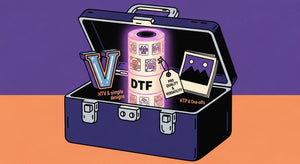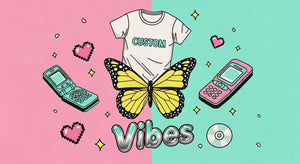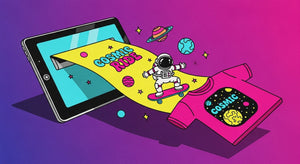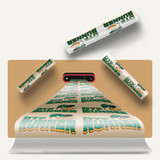Table of Contents
- How Screen Printing Came into Limelight
- Characteristics of Screen Printing
- The History of Screen Printing
- Screen Printing Process
- Improvements in Printing Technology
- Introducing DTF Printing
- How DTF Printing Works
- Advantages of DTF Transfer Images
- Comparison between Screen Printing and DTF Transfer Images
- Use Cases for Each Method
- The Future of Printing Technology
- Challenges and Considerations
Printing industries have come a long way from the traditional methods of the early years to the current innovations; with each step, it created more efficiency and brought creativity. One of the recent developments in this regard is DTF, direct-to-film printing. This content is on the evolution of printing, specifically the change from screen printing to DTF transfer images.
How Screen Printing Came into Limelight
Screen printing, also known as silk screening, is one of the oldest techniques of image transference onto different kinds of surfaces. It is based on a technique for forming a stencil, also called a screen, and then using it as the means for applying many layers of ink on a printing surface. What really made it so popular was the vivid, hard-wearing prints created.

Characteristics of Screen Printing
-
Durable: Inks used for screen printing are thick and resistant to wash and wear, that’s why the ink is perfect for use on textiles.
-
Vibrant Colors: Accommodates bright loud colors that really pop, which is what makes designs outstanding.
-
Versatility: It can be done on so many materials, such as fabric, glass, and metal.
On the other hand, aside from those advantages, it has some disadvantages like long set-up time, and complex designs are less suitable for this process.
The History of Screen Printing
The process of screen printing is very ancient, dating back as far as the Song Dynasty in China from 960 to 1279 AD. The process methodically spread to the rest of the Asian countries, including Japan, before crossing to the West to reach Europe in the late 18th century. In the early 20th century, screen printing was already popular and an accepted technique for commercial and art applications; generalized applications then spread to the textile industry.
Screen Printing Process
The process of screen printing has these stages:
-
Making the Screen: A mesh screen is, primarily, coated with a light-sensitive emulsion. The image or design is then imposed on the screen by exposure to a UV light exposure unit.
-
Preparation of Ink: Special inks are mixed by the manufacturer to the desired color and consistency.
-
Printing: The screen is placed over the printing surface, and ink is pushed onto the screen with a squeegee. The ink goes through the mesh onto the substrate and forms a print.
-
Curing: Heat is applied to the printed entity to dry the ink, thus making it durable and washable.
Improvements in Printing Technology
When technology advanced, digital methods of printing started to enter the printing market. This provided quicker production time and detailed prints that meet modern businesses and creative professionals based on demand. One such innovation in this field is direct-to-film printing.
Introducing DTF Printing
Basically, DTF printing is the newest breakthrough in quality printing controlled by textiles. Having said so, DTF does not require the opening of any kind of screens or stencils compared to screen printing. This special printer prints a design onto a film and then, with heat transfer, it goes on the fabric.
How DTF Printing Works
The process of DTF printing consists of some fundamental steps that start with:
-
Design Creation: The design is made on the computer and set up for printing.
-
Printing on Film: A special printer prints the design onto a PET film using DTF inks and creates the design.
-
Powder Application: Apply a hot-melt adhesive powder to the printed film, only adhering to the ink.
-
Curing: Cure the film with the adhesive powder on it. This will ensure the hold.
-
Transfer: The printed film is laid over the fabric and pressed using the heat press. The heat activates the adhesive and adheres the image to the t-shirt, thus bonding it onto the fabric.
Advantages of DTF Transfer Images
DTF transfer images have numerous benefits over the use of the traditional screen printing methods. These advantages have greatly advanced the popularity of the DTF in use amongst many people and businesses.
High Detail and Quality
DTF printing allows for complex designs and high-resolution images that can be pretty challenging to achieve with screen printing. The prints obtained are very sharp, vivid, and detailed; meaning it is very appropriate for custom designs.
Cost-Effective for Small Runs
Unlike screen printing, which comes with heavy set-up costs, DTF Printing is quite economical even for small runs. This makes it of better choice in regard to custom orders and small business ventures.
Versatility
DTF transfer images can be applied to various fabrics, including cotton, polyester, and blends. The wide array of different applications to which prints can be used now ranges from custom-made apparels to promotional products.
Durability
DTF prints are long-lasting and resistant to washing and wearing. All the prints look brilliant and are water-wash-resistant, wash after wash.
Environmental Impact
It can have a lower environmental impact compared to traditional screen printing. Less waste is generated from the processes, as no screens or excessive use of ink is required. More so, a number of DTF inks are water-based, reducing the use of harmful chemicals.

Comparison between Screen Printing and DTF Transfer Images
When choosing between screen printing and DTF transfer images, it is essential to consider the specific needs of your project. Each method has its own set of advantages and disadvantages.
Screen Printing Pros and Cons
-
Pros:
- Ideal for large production runs
- Produces vibrant and durable prints
- Suitable for simple designs with limited colors
-
Cons:
- Longer setup times
- Higher costs for small runs
- Limited detail and complexity in designs
DTF Transfer Images Pros and Cons
-
Pros:
- High detail and quality
- Cost-effective for small runs
- Versatile and suitable for various fabrics
- Durable and long-lasting prints
-
Cons:
- May not be as cost-effective for very large runs
- Requires specialized equipment and materials
Use Cases for Each Method
-
Screen Printing: Suitable for large production runs, simple designs, and projects requiring vibrant and durable prints. Commonly used in T-shirts, posters, and signage.
-
DTF Transfer Images: It is ideal for custom orders, small production runs, and intricate designs. Suitable for various fabrics and promotional items.
The Future of Printing Technology
Innovations in the printing industry never stop. New technologies have been cropping up to help answer growing needs for efficiency, better quality, and creativity. DTF printing makes one more remarkable leap ahead, bridging the capacity to combine high detailing, versatility, and cost-effective solutions. The more businesses and consumers utilize this technology, the more innovations that will happen, taking printing to even greater heights.
Potential Innovations
-
Better Inks and Materials: Constant research and development conducted on inks and substrates will further increase quality and durability of DTF prints.
-
Automation: Improvements made on automation of printing via DTF are easier, faster, and cheaper.
-
Eco-Friendly Solutions: Our world is so beautiful! We need to protect these beauties. So, the industry now prefers more sustainable practices, and eco-friendly inks and materials are becoming more widely available.
Challenges and Considerations
Though DTF printing provides a number of advantages, one cannot turn a blind eye to the challenges. The initial investment in specialized equipment can be a barrier for some businesses. Additionally, staying updated with the latest technological advancements and maintaining high-quality output will require ongoing education and adaptation.

The evolution of printing from traditional screen printing to modern DTF transfer images highlights the industry's advancements in technology and creativity. While screen printing remains a reliable method for many applications, DTF printing offers exciting new possibilities for detailed, cost-effective, and durable prints. By understanding the benefits and limitations of each method, businesses and individuals can make informed decisions to meet their specific printing needs. As we look to the future, the ongoing development in printing technology promises even more innovative solutions and opportunities for creativity.
In conclusion, both screen printing and DTF transfer images have their unique places in the printing industry. Screen printing continues to be valued for its durability and vibrancy, especially in large production runs. However, DTF transfer images bring a new level of detail, cost-efficiency, and versatility that meets the needs of modern, customized printing projects. By embracing the strengths of each method and staying informed of technological advancements, the printing industry can continue to evolve and thrive in an increasingly digital world.






